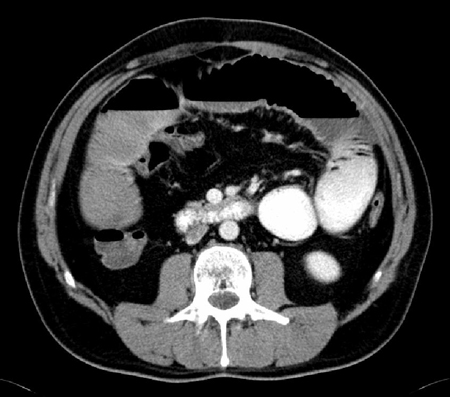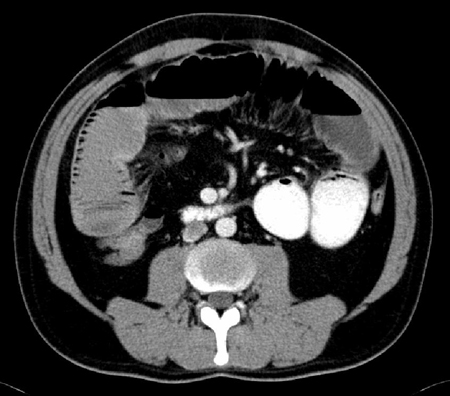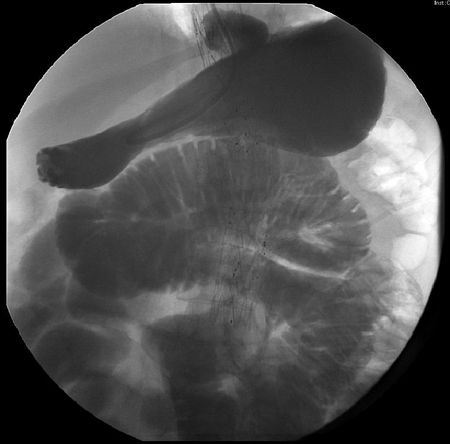Recommendations
Key Recommendations
Clinical diagnosis is based on the history and physical exam. The goals of further diagnostic evaluation are to identify any reversible conditions and to differentiate between ileus and mechanical bowel obstruction. Mechanical obstruction can be excluded with the following tests.[77]
Computed tomographic (CT) scan of the abdomen and pelvis.
Water-soluble small bowel series and/or contrast enema.
History
Patients typically complain of nausea, vomiting, hiccups, constipation (which may be severe), or failure to pass flatus, and discomfort from gaseous distention and cramping, usually without significant pain.[3][78]
History of postoperative ileus, gastrointestinal (GI) motility disorders, and recent surgery, and current medications and comorbidities should be evaluated.
Most patients presenting with ileus will have recently undergone surgery, and the surgeon should have an understanding of potential intra-operative complications (e.g., bowel resection should raise concern of possible technical problems with the anastomosis; recent cardiac surgery may be associated with low-flow-state intestinal ischemia). The current medication history is helpful, as many sedatives and analgesics slow down GI motility.[3] Hospitalized patients are often placed on several of these types of medications concurrently.
It is important to find out about other risk factors for ileus including history of recent acute systemic illnesses (e.g., myocardial infarction, pneumonia, acute cholecystitis, pancreatitis, sepsis).[24]
Physical exam
The abdominal examination reveals distention but without significant tenderness to palpation. The abdomen should be examined for any evidence of mechanical obstruction such as hernias, and for any evidence of peritoneal inflammation.
Vital signs should be evaluated as the patient may be hypovolemic or hemodynamically unstable due to underlying conditions. A hypovolemic patient may be expected to present with mild tachycardia or hypotension, though severe abnormalities could indicate a different diagnosis. Hypovolemia may also manifest as low urine output (normal urine output for an adult is above 0.5 mL/kg/hour).
Initial tests
Electrolytes, complete blood count, and abdominal and pelvic CT scan are the initial tests to perform in anyone with a clinical diagnosis of ileus.[77] Contrast-enhanced CT acquisition is sufficient for the assessment of possible small bowel obstruction (SBO); unenhanced images do not add diagnostic information.[79]
Ileus and obstruction may be accompanied by hypokalemia and hypochloremia. Hypermagnesemia may be present. Alkalosis may be present in dehydrated states, and acidosis may be present in intestinal ischemia. Alkalosis and/or acidosis can be inferred from the carbon dioxide level that is found on a standard chemistry panel. A significantly elevated white blood cell level is an unexpected finding in a patient with ileus, and another cause should be considered.
For those on parenteral nutrition, electrolytes should be checked daily to identify electrolyte abnormalities associated with postoperative intravenous feeding and the nothing by mouth state.
Further investigations
Liver function tests as well as amylase and lipase are useful when causes for ileus other than postsurgery, such as cholecystitis or pancreatitis, are suspected.
In postoperative patients, a CT scan should be performed if the presumed ileus has not resolved in 5-7 days, or the clinical condition of the patient worsens.[32] CT scan of the abdomen may be performed with intravenous contrast and oral water-soluble contrast. In the immediate postoperative period, CT scan with oral contrast is the method of choice in differentiating prolonged ileus and mechanical obstruction.[80][81] This may help to identify a transition zone in a mechanical obstruction, and exclude any intra-abdominal fluid collections or anastomotic complications. Contrast-enhanced CT acquisition is sufficient for the assessment of possible SBO; use of unenhanced CT alongside contrast-enhanced imaging does not add diagnostic information and should be avoided.[79]
In cases of prolonged ileus (occurring on or after day 4 postsurgery without prior resolution of postoperative ileus), a small bowel series may be done to evaluate for any evidence of mechanical obstruction that may have been missed on a CT scan.[3][4]
Rarely, in patients with other risk factors for gastroparesis or gastric outlet obstruction, a gastric emptying study may be considered. [Figure caption and citation for the preceding image starts]: CT scan with intravenous and oral contrast showing fluid-filled small intestine and cecum in ileusFrom the personal collection of Dr Paula I. Denoya [Citation ends]. [Figure caption and citation for the preceding image starts]: CT scan with intravenous and oral contrast showing fluid-filled small intestine in ileusFrom the personal collection of Dr Paula I. Denoya [Citation ends].
[Figure caption and citation for the preceding image starts]: CT scan with intravenous and oral contrast showing fluid-filled small intestine in ileusFrom the personal collection of Dr Paula I. Denoya [Citation ends]. [Figure caption and citation for the preceding image starts]: Small bowel series showing dilated small bowel loops in ileus; nasogastric tube is seen curled in the stomachFrom the personal collection of Dr Paula I. Denoya [Citation ends].
[Figure caption and citation for the preceding image starts]: Small bowel series showing dilated small bowel loops in ileus; nasogastric tube is seen curled in the stomachFrom the personal collection of Dr Paula I. Denoya [Citation ends]. [Figure caption and citation for the preceding image starts]: Small bowel series showing dilated contrast-filled small bowel loops in ileus; some contrast is visible in the right colonFrom the personal collection of Dr Paula I. Denoya [Citation ends].
[Figure caption and citation for the preceding image starts]: Small bowel series showing dilated contrast-filled small bowel loops in ileus; some contrast is visible in the right colonFrom the personal collection of Dr Paula I. Denoya [Citation ends].
In patients with renal insufficiency, caution should be exercised prior to administering intravenous contrast, which can be avoided if necessary. Water-soluble contrast should be used in place of barium, as barium contrast preparations are contraindicated in patients with suspected GI tract perforation. Barium peritonitis is associated with a high mortality. Also, barium may become inspissated in the bowel if it remains there for a significant amount of time, as may happen in an ileus or obstruction.
Use of this content is subject to our disclaimer